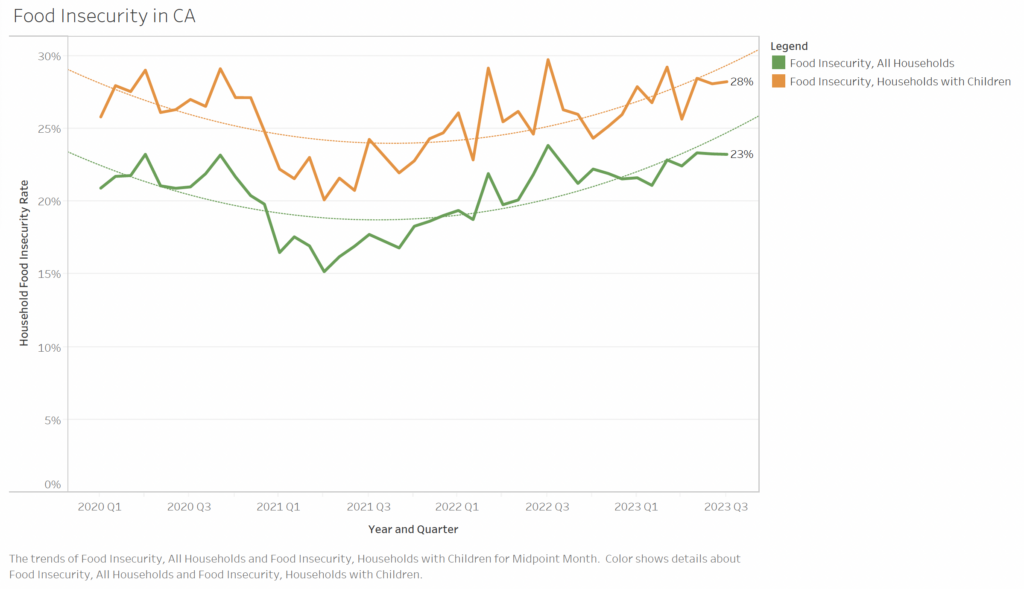The Impact of CalFresh (SNAP) Emergency Allotments
December 12, 2023
We do not offer food. Here’s where you can find food.
As the COVID-19 pandemic took hold, what started as a health crisis quickly became an economic and hunger catastrophe. With schools shuttered, layoffs rippling through our communities, and the entire state coming to a standstill, millions of Californians found themselves without a way to put food on the table. Within days of stay-at-home orders being enacted, food banks were setting up new and expanded programs to respond to an unprecedented demand.
While CAFB worked closely with the state to get food boxes on the road, Congress, under Speaker Pelosi’s leadership, acted immediately to pass the Families First Coronavirus Response Act, allowing states to issue “Emergency Allotments (EAs)” that increased SNAP / CalFresh benefits up to the maximum benefit level for a household size.
California moved quickly to implement CalFresh EAs starting in March 2020, and subsequently every month until March 2023 when they ended Federally – benefitting more than 3 million households. In 2021 alone, EAs helped Californians purchase 1.32 billion meals, or approximately 14% of the meals provided through all public and private food assistance programs in the state combined. Over the course of three years, EAs totaled approximately $14 billion in federally funded food benefits.
The team at the California Association of Food Banks wanted to truly understand the impact of EAs on Californians as well as the impact of their subsequent end. We conducted a mixed-methods study to find out and published a policy brief summarizing the findings and calling for proven solutions.
In February 2023, CalFresh households received around $180 in EAs on average. The larger the household, the more in EAs they received. Of households enrolled in CalFresh that were already at the maximum benefit level for their household size received an EA of $95 per month. All other households received EAs equivalent to the amount needed to bring them to the maximum (or $95, whichever was more).
“It was a tremendous, huge weight off my shoulder, because I was actually getting groceries and I was getting a healthy meal, and stuff that I find difficult to get on a normal basis.”
– CalFresh Recipient
With the signing of the Consolidated Appropriations Act of 2023, EAs were untethered from the Federal Public Health Emergency status and brought to a premature end. In California, this meant SNAP/CalFresh households received their last EA on March 26, 2023, after which their benefits dropped by 32-40%. This happened at the same time that food prices in the Western United States were 8% higher the previous year and the costs of transportation, housing, and other goods had been skyrocketing.
“My biggest expenses right now is all my money goes to the utilities, gas and light. I don’t have money to get school clothes for my kids, and school shoes. Like, everything is going to the utilities and not towards the day to day needs.”
– CalFresh Recipient
It is no surprise that as soon as EAs ended, food banks began seeing the impact in their communities. In 2023 CAFB fielded two “pulse” surveys on the needs food banks were responding to in their communities. Through these surveys, which asked about April and July 2023 respectively, we learned that:
The latest data from the Census Household Pulse Survey shows that nearly 1 in 4 households in California are facing food insecurity today, while nearly 1 in 3 households with children are food insecure. Communities of color – Black and Latine households in particular – are facing deep and disproportionate impacts. These rates are comparable to those in 2020, during the early stages of the pandemic:

Our following recommendations include Federal and State policies that are key to making permanent progress on the hunger-fighting power of SNAP/CalFresh:
Improve benefit adequacy:
Expand eligibility and end exclusionary rules:
Bolster the emergency food network:
Hunger is a policy choice and a solvable problem, but it takes the support and will of us all. Joins us as we work toward a hunger-free California:
Ask your Member of Congress to co-sponsor federal bills listed above
Ask your State Senator and Assemblymember to support policies and investments to end hunger
Support your local Food Bank: Donate or volunteer!
*”In February 2023, CalFresh households received around $180 in EAs on average” was edited on December 14, 2023 to reflect newly available data from CDSS, the original number said $252.